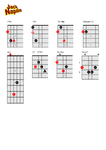hank":2npvhwui said:
to start closer to the beginning, a powerchord is a 5 chord as in A5 or E5. You fret a root note and it's 5th note and there you are. Is "5 chord" the correct technical name? I'll also use powerchords comprising a root and it's 4th, a root and 3rd, and a root and flat 3rd. Do these have "real" names?
And for the root and 4th, for example fretting at 6th string 5th fret (A) and 5th string 5th fret (D), is that an A something or is it an inverted D5 with the 5th in the bass or can it be either depending on the context/usage?
ok, so after a little research it appears that the root and 4th is an INVERSION of the power chord, like the power chord turned upside down note-wise. The root is on the higher string and the 5th on the lower/bass string. This is the power chord form Blackmore used for Smoke On The Water. And instead of strumming them he plucked both strings simultaneously.
So for example, fretting at 6th string 5th fret (A) and 5th string 5th fret (D), give you the inverted form of the D5 power chord.
As someone else mentioned, these aren't "real" chords if you want to be strictly technical, they are intervals. The root and the 3rd gives you a major sound and the root and flat 3rd a minor sound. The power chord, since it doesn't contain a 3rd (flat or natural) is ambiguous sounding so I guess it can go either way depending on the context.

